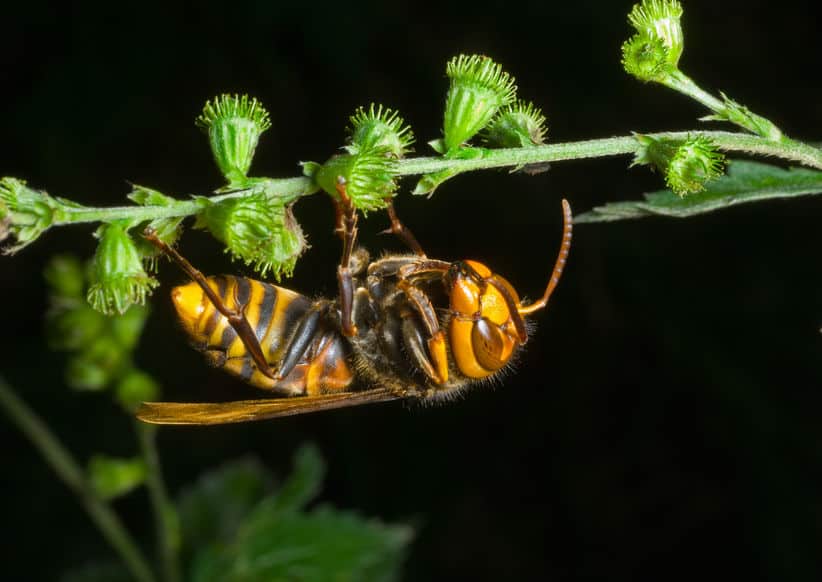Also known as the Asian giant hornet, Vespa mandarinia, the murder hornet is found mostly in Asia.
How big are murder hornets?
While not the largest wasp, it is the largest social species. It can reach up to 2 inches (5cm) in size. Although this is the size of the queen, the worker hornets are smaller at around 1.5 inches. Social species live in colonies as opposed to solitary wasps that do not live in social groups. The fact that thousands of these large insects form a single colony makes them a very daunting prospect for people and potential predators alike.
How fast can murder hornets fly?
Out of all wasp species, murder hornets have recorded the fastest flying speeds. They have been clocked at 25 mph (40 km/h). Outrunning these hornets is not going to be very effective, to say the least.

Are murder hornets aggressive?
They are not actively aggressive towards humans. Like other hornet species, murder hornets will mostly stay away from humans, but food sources and human proximity to their nests may bring them into conflict. Murder hornets are less aggressive than other common species of wasp such as yellow-jackets.
Can murder hornets kill people?
Murder hornets are responsible for perhaps a few hundred deaths each year across the world. What makes them dangerous is their size and number. If attacked by a large number then the venom inflicted can be deadly. One or two stings, while painful, are not going to harm most people, but after 30 or so stings then the situation can become more serious.
What eats murder hornets?
In parts of Japan, murder hornets make a grilled snack. People in Kushihara and the surrounding regions of Japan are known to consume murder hornets, as well as the larvae from the Hebo wasp. They even have a wasp festival each year known as the Kushihara Hebo Matsuri Wasp Festival. Read more about it here.
Other than people they have very few predators. The European Honey-buzzard is known to eat murder hornet larvae but their habitats don’t usually overlap.
What are murder hornets called in Japan?
In Japan, they are called giant sparrow bees. The Japanese do not have different common names for bees, wasps, and hornets and in effect call them all bees. In Japanese the common name ōsuzumebachi (オオスズメバチ(大雀蜂) meaning giant sparrow bee describes the murder hornet.
Are murder hornets a threat to bees?
They can eradicate a honey bee colony in as little as 2 hours. Murder hornets raid beehives in order to access both the honey and the bee brood from within the nest. They are ruthless when they attack a hive in numbers and they will first decapitate the worker bees before entering the hive. In Asia, honey bees have developed defense strategies. The bees will form a ball with their bodies, enclosing the hornets within. The friction created kills the hornets. Wasps in Europe and America have not evolved these tactics, however.
Do murder hornets have big stingers?
The stinger is long enough to penetrate thick clothing. Due to their size, regular protective clothing used by beekeepers is not adequate protection from these hornets. The stinger is around 1/4 of an inch (6mm long). Luckily they do not readily attack people. Staying well clear of their nest is very important, however, as being stung by these hornets is a serious business.
Where do murder hornets nest?
They nest underground in forest environments. Murder hornets do not favor urban environments and typically nest under tree roots or in underground cavities formed by animal burrows. The depths of the nests vary from only 2 inches (6 cm) down to 24 inches (60 cm).
Can murder hornets spray venom?
Murder hornets are known to be able to spray venom. Bears are a natural predator for murder hornets as they are attracted to the concentration of hornet larvae in the nest. Spraying venom is a defense used against bears, but also humans. One such case can be found in a report of a 77-year-old in Japan suffering permanent eye damage as a result of the venom. Other wasp species such as bald-faced hornets can also spray venom.
